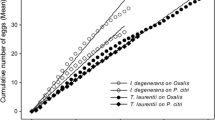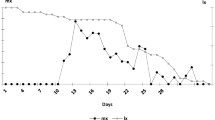Abstract
The immature stages of the preclaceous mite Typhlodromus talbii Athias-Henriot are described. The mite was reared on different prey species and pollen in the laboratory, and its developmental parameters calculated. Tydeus californicus (Banks) was found to be the most suitable and nourishing diet, giving a shorter life cycle and higher female fecundity (8.8 days and 33.4 eggs respectively), than the scale insect Coccus acuminatum (Gennadius) (10.0 days and 24.8 eggs respectively) at 25 °C. Other associates of Typ. talbii, the eriophyid Cesaberoptus kenyae Keifer, the tetranychid Oligonychus mangiferus (R. & S.) as well as date palm and castor oil pollen, were unsuitable diet. When reared on moving stages of Tyd. californicus (Banks) at 70 ± 5 % RH, 16:8 (L:D) h photoperiod and temperatures of 15, 20, 25, 28, 30, 32 and 35 °C, the total developmental time of Typ. talbii averaged 21.3, 12.4, 8.8, 7.6, 7.1, 5.8 and 11.6 days respectively. The intrinsic rate of natural increase (rm) and the net reproduction (R0) reached maximum values of 0.299 individuals per female per day and 28.06 times respectively, at 32 °C.
Résumé
Les Stades juvéniles de l’acarien prédateur Typhlodromus talbii Athias-Henriot sont décrits. L’acarien a été élevé au laboratoire sur différentes espèces de proies et différents pollens, et ses paramètres de développement calculés. Tydeus californicus (Banks) a été la proie la mieux adaptée et la plus nourrissante ayant donné à 25 °C un cycle de vie plus court et une plus forte fécondité (8.8 jours et 33.4 oeufs respectivement), que la Cochenille Coccus acuminatum (Gennadius) (10.0 jours et 24.8 ceufs respectivement). Les autres régimes alimentaires de T. talbii, l’Eriophyide Cesaberoptus kenyae Keifer, le tétranyche Olygonychus mangifera (R. & S.), de même que les pollens du palmier dattier et du ricin sont des nourritures inapropriées. Lorsqu’il a été élevé sur des Stades mobiles de T. californicus à 70 ± 5% HR, 16/8 (J:N) de photopériode et à des températures de 15, 20, 25, 30, 32 et 35 °C, la durée totale du développement de T. talbii est en moyenne de 21.3, 12.4, 8.8, 7.6, 7.1, 5.8 et 11.6 jours respectivement. Le taux intrinsèque d’accroissement naturel (rm) et le taux net de reproduction (Ro) ont des valeurs maxima de 0.299 individus par femelle et par jour et 28.06 respectivement, à 32 °C.
Similar content being viewed by others
References
Abou-Awad B. A., El-Sherif A. A., Hassan M. R and Abou-Elela M. M. (1998a) Life history and life table of Amblyseius badryi, as a specific predator of eriophyid grass mites (Acari: Phytoseiidae: Eriophyidae). Z. Pflanzenk. Pflanzenschutz 105, 422–428.
Abou-Awad B. A., El-Sherif A. A., Hassan M. R and Abou-Elela M. M. (1998b) Laboratory studies on development, longevity, fecundity and predation of Cydnoseius negevi (Swirski & Amitia) (Acari: Phytoseiidae) with two mite species as prey. Z. Pflanzenk, Pflanzenschutz 105, 429–433.
Abou-Setta M. A., Sorrell R. W. and Childers C. C. (1986) Life 48: A basic computer program to calculate life table parameters for an insect or mite species. Fla. Entomol. 69, 690–697.
Amitia S., Wysoki M. and Swirski E. (1969) A case of thelytoky in a phytoseiid mite (Acarina: Mesostigmata) with cytological studies. Isr. J. Agric. Res. 19, 49–52.
Athias-Henriot C. (1975) The idiosomatic euneotaxy and epineotaxy in gamasids (Arachnida, Parasitiformes). Z. Zool. Syst. Evol. Forsch. 13, 97–109.
Birch L. C. (1948) The intrinsic rate of natural increase of an insect population. J. Anim. Ecol. 17, 15–26.
El-Badry E. A., Afifi A. M., Issa G.I. and El-Banhawy E. M. (1968) Effectiveness of the predaceous mite Amblyseius gossypii as a predator of the three tetranychid mites (Acarina: Phytoseiidae). Z. angew. Ent. 62, 189–194.
El-Banhawy E. M. and El-Bagoury M. E. (1991) Biological studies of the predaceous mite Typhlodromus pelargonicus. A predator of the two spotted spider mite Tetranychus urticae on cucumber plants (Acari: Phytoseiidae: Tetranychidae). Entomophaga 36, 587–591.
Fleschner C. A. and Arakawa K. Y. (1953) The mite Tydeus californicus on citrus and avocado leaves. J. Econ. Ent. 45, 1092.
Ibrahim S. M. (1988) Ecological and biological studies on some predacious mites associated with citrus trees in Egypt. PhD Thesis, Cairo Univ., 148 pp.
Kennet C. E. (1958) Some predaceous mites of the subfamilies Phytoseiinae and Aceosejinae (Acarina: Phytoseiidae, Aceosejidae) from central California with description of new species. Ann. Ent. Soc. Am. 51, 471–479.
Kinsley C. B. and Swift F. C. (1971) Biological studies of Amblyseius umbraticas (Acarina: Phytoseiidae). Ann. Ent. Soc. Am. 64, 813–822.
Kolodochka L. A. (1974) Case of thelytoky in the mite Amblysieus herbarias (Parasitiformes, Phytoseiidae). Ekologya 5, 95.
Kolodochka L. A. (1975) Acase of thelytoky in Amblyseius agretis (Parasitiformes: Phytoseiidae). Vestn. Zool. 2, 84–85.
Lindquist E. E. and Evans G. O. (1965) Taxonomic concepts in the Ascidae with a modified setal nomenclature for the idiosoma of the Gamasina (Acarina: Mesostigmata). Mem. Ent. Soc. Can. 47, 1–66.
McMurtry J. A. (1992) Dynamic and potential impact of generalist phytoseiids in agroecosystems and possibilities for establishment of exotic species. Exp. Appl. Acarol. 14, 371–382.
McMurtry J. A., Huffaker C. B. and van de Vrie M. (1970) Ecology of tetranychid mites and their natural enemies: A review. 1-Tetranychid enemies: Their biological characters and the impact of spray practices. Hilgardia 40, 331–390.
van der Merwe G. G. (1968) A taxonomic study of the family Phytoseiidae (Acari) in South Africa with contributions to the biology of two species. Entomol. Mem. Dep. Agric. Tech. Serv. Repub. S. Afr. 18, 1–198.
Momen F. M. and El-Sawy S. A. (1993) Biological and feeding behaviour of the predatory mite Amblyseius swirskii (Acarina: Phytoseiidae). Acarologia 34, 199–204.
de Moraes G. J. and McMurtry J. A. (1981) Biology of Amblyseius citrifolius (Denmark and Muma) (Acarina: Phytoseiidae). Hilgardia, Entomol. 49, 1–29.
Muma M. H. (1964) The population of Phytoseiidae on Florida citrus. Fla. Entomol. 47, 5–11.
Nassar O. A. (1976) Incidence of predaceous mites on fruit trees in North East of Delta, with emphasis on Cunaxa seterostis (Hermann) MSc Thesis, Fac. of Agriculture, Cairo Univ., 91 pp.
Rowell H. J., Chant D. A. and Hansell I. C. (1978) The determination of setal homologies and setal pattern of the dorsal shield in the family Phytoseiidae (Acarina: Mesostigmata ). Can. Ent. 110, 859–876.
Sabelis M. W. (1981) Biological control of two spotted spider mite using phytoseiid predators. Part 1-Agricultural Research Reports 910. Pudoc, Wageningen, (Netherlands), 242 pp.
Soliman Z. R., Zaher M. A. and El-Safy G. S. (1974) An attempt for rearing Tydeus californicus (Banks) on sweet potato leaves in Egypt. Bull. Soc. Ent. Egypt 58, 217–220.
Takahashi F. and Chant D. A. (1994) Adaptive strategies in the genus Phytoseiulus Evans (Acari: Phytoseiidae) survivorship and reproduction. Int. J. Acarol. 20, 87–97.
Tanigoshi L. K., Hoyt S. C, Browne R. W. and Logan J. A. (1975) Influence of temperature on population increase of Metaseiulus occidentalis (Acarina: Phytoseiidae). Ann. Entomol. Soc. Amer. 68, 979–986.
Wahab A. E. A., Yousef A. A. and Hemeda H.M. (1974) Biological studies on the tydeid mite Tydeus californicus. (Banks) (Acarina, Tydeidae). Bull. Soc. Entomol. Egypt 58, 349–353.
Wahba M. L. (1976) Studies on tydeid mites (Family Tydeidae), especially as related to mango and citrus trees. PhD Thesis, Ain Shams Univ. 119 pp.
Author information
Authors and Affiliations
Rights and permissions
About this article
Cite this article
Zaher, M.A., El-Borolossy, M.A. & Ali, F.S. Morphological and Biological Studies on Typhlodromus talbii Athias-Henriot (Gamasida: Phytoseiidae). Int J Trop Insect Sci 21, 43–53 (2001). https://doi.org/10.1017/S1742758400020038
Accepted:
Published:
Issue Date:
DOI: https://doi.org/10.1017/S1742758400020038




